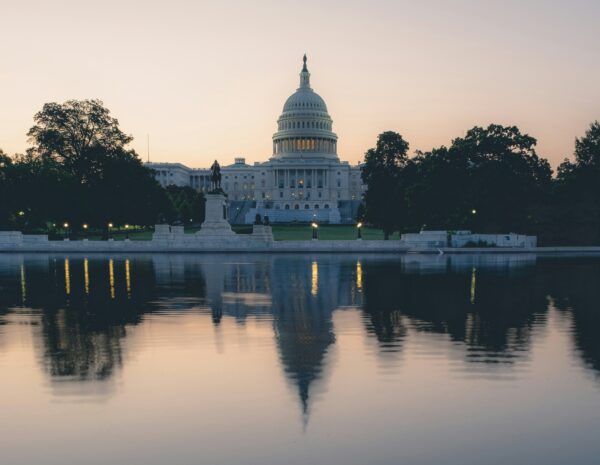Technology has always been a key driver of climate change. Since the Industrial Revolution, technologies like the internal combustion engine and coal fired power plants have contributed to increased greenhouse gas emissions.
Yet, technology can and must be part of our climate solution. This includes technological advancements in energy production, manufacturing, battery storage, and much more. These solutions are necessary to address the effects of climate change and global heating.
Technology is a critical weapon in our fight against climate change. Around the world, climate policy experts and other leaders are working to ensure technology is responsibly and effectively integrated into climate plans.
Technological advancement will not save us from the impacts of climate change. We’re already feeling the impacts of increased temperatures, rising sea levels, and intensifying natural disasters. Yet, when responsibly used and combined with nature-based approaches, technology can help us mitigate climate impacts. Technological innovation can help us build a greener, healthier future.
Integrating Technology Into Climate Policy
We cannot hope to prevent or reverse climate change without significant technological innovation. To slow the pace of global heating, we must change the ways we produce energy, grow food, travel, and more. This is especially true in the United States, where harmful manufacturing processes dominate the economy. In a society reliant on pollutant energy sources, Americans’ carbon footprints are disproportionately high. Improving the sustainability of our society and economy will require technological innovation in nearly every sector. Advancements must reach from energy production to agriculture, construction, and transportation.
Change on this scale will not happen on its own. Leaders must work proactively to encourage the development and adoption of greener technology. Fortunately, this important work to solve the climate crisis has already begun. Creative policy solutions encourage — or even require — the adoption of key climate technologies.
Reducing Emissions
Improved energy efficiency allows us to reduce emissions without reducing service usage. For example, an energy efficient washer and dryer allows a consumer to reduce their energy use without reducing how often they do laundry, or the amount of clothes they wash. Both the federal and state governments have set energy efficiency standards for appliances and building codes. Manufacturers and builders alike must meet these efficiency targets.
Companies face energy efficiency challenges when making these kinds of technological upgrades. Thus, governments have also established incentive programs that encourage and reward the private sector for taking steps to increase efficiency and reduce emissions. The U.S. Department of Energy maintains a database to track and publicize available incentive programs.
Of course, the easiest and cheapest way to reduce emissions is to use less energy. Individuals can walk or bike rather than drive, run the air conditioning less in the summer, take fewer flights. But, convincing the population to make these lifestyle changes is challenging. Further, placing the onus of reducing emissions on individuals rather than large corporations who pollute the most seems counterintuitive. Given this reality, technological improvements to reduce emissions are critical.
Renewable Energy
Making the transition to renewable energy is also key. The U.S. has high energy needs, currently mostly met by burning fossil fuels. Switching to clean, renewable energy sources would reduce greenhouse gas emissions. This transition will require massive technological improvements in both renewable power generation and energy storage.
Renewable energies like solar and wind are already much more affordable than they were in the past. They’re much better quality, too. This is thanks to the work of climate scientists and researchers. Between 2010 and 2020, the cost of solar panels dropped by about 85%. Costs are expected to continue to fall. Improvements in the solar sector are a great example of how technology can improve climate outcomes. Reducing the cost of renewable energy eases the transition to cleaner energy sources. With lower costs, governments and consumers alike are better able to make the shift from fossil fuels to sustainable energy.
Batteries and energy storage is one of the most critical areas of climate technology research. The cleanest renewable energies like solar and wind are inherently intermittent. When it is sunny or windy, these technologies may generate energy in excess of demand. But on cloudy, still days they may not supply enough. With high-energy density battery storage, excess energy can be stored, quite literally, for a rainy day. At present, our battery technology is not capable of storing the energy density we need to run the economy. Improving battery capacity and reducing energy storage costs requires significant research. Without advancement in this sector, the U.S. will struggle to meet emissions goals.
Electric Vehicles
Twenty-nine percent of greenhouse gas emissions in the U.S. come from the transportation sector. Cars and light duty trucks are responsible for 58% of those transportation emissions. Cars contribute massively to America’s carbon emissions problem. Any serious climate plan must include policies to reduce motor vehicle emissions.
Many climate activists are skeptical of electric vehicles (EVs), and for good reason. Electric cars require batteries full of rare earth minerals. These necessary minerals are mined with dangerous, polluting methods. Further, EVs don’t address the land use problems that accompany a transit system reliant on private vehicles. Public transit, biking, and walking are all more climate friendly than electric cars.
Still, the U.S. is built around cars. Transitioning to other modes of transportation takes time, and EVs will reduce transportation emissions in the short-term. Increasing their affordability and use will help reduce transportation emissions today. The Biden Administration has set a national target of 50% EV sales share by 2030. To support this goal, the Administration launched the EV Charging Action Plan. The Plan sets forth a roadmap build out a national network of EV chargers. It also included new tax credits for electric vehicle purchases in the Inflation Reduction Act.
Smart Development
Though less damaging than transportation, the development and buildings sector also contributes to emissions. Commercial and residential buildings make up about 13% of total greenhouse gas emissions. Increasing the efficiency of new and old buildings will improve climate outcomes.
The U.S. has set aggressive new efficiency standards for utility providers and appliance manufacturers. These standards aim to reduce energy use in residential and commercial buildings, while also reducing utility costs for consumers. The Administration also recently launched the Biden-Harris Action Plan for Building Better School Infrastructure. The Plan invests $500 million in energy efficiency upgrades for public school buildings across the U.S.
President Biden’s Climate Agenda and Key Climate Policies
President Biden campaigned on fighting climate change through building a greener economy. He has set ambitious climate goals while in office. In particular, the Biden Administration has committed the U.S. to reducing greenhouse gas emissions to 50% of 2005 emissions levels by 2030, and to achieving net-zero emissions by 2050. To realize these climate goals, the Biden Administration is taking a whole-of-government approach. Climate policies are a key feature of the Administration’s two signature domestic policy achievements: the Inflation Reduction Act and the Infrastructure Investment and Jobs Act, also known as the Bipartisan Infrastructure Law.
Both laws made massive investments in the following areas, among others:
- Low-carbon technologies
- Climate tech research
- Renewable energy deployment
- Legacy pollution mitigation
The Administration has also invested in clean energy manufacturing and EVs. It has also made environmental justice a priority when implementing these new programs. President Biden’s climate agenda attempts to activate every sector of the economy in the fight against climate change. This effort enlists a broad range of federal agencies, state-level programs, and private sector actors to reduce emissions and mitigate the impacts of global heating.
Technology’s Role in President Biden’s Climate Agenda
President Biden’s climate policies have invested billions in climate technology. Both the IRA and the Bipartisan Infrastructure Law launched huge new spending programs for clean power investments, the domestic manufacturing of renewable energy technology, offshore wind installations, and more.
These bills also created new revenue streams for research and development. The Administration launched the Energy Earthshots Initiative. Housed in the U.S. Department of Energy, the initiative aims to accelerate breakthroughs in clean energy technology. It supports “moonshot-style” big ideas in the world of climate technology, with a focus on:
- Carbon capture and storage
- Clean fuel production
- Grid-scale battery energy storage
- Industrial heat decarbonization projects
- Novel renewable energy sources like hydrogen and floating offshore wind
Many of these technologies are currently underdeveloped or too expensive to be feasible. As such, the Energy Earthshots Initiative seeks to invest in these nascent technologies and support their ongoing development. A new discovery in these sectors could revolutionize the energy future in the US. Such a development would help the country meet ambitious emissions reductions goals.
Key Aspects of President Biden’s Climate Agenda
The Biden Administration has also prioritized environmental justice in its climate policies. Historically, low-income and communities of color have both received less federal infrastructure investment than their wealthy, white peers. They’ve also been forced to absorb more of the negative externalities associated with climate change and environmental pollution. This inequality is reflected in the poor public health of many low income and communities of color. The environmental justice movement is working to redress this inequality.
In 2021, Biden launched the Justice40 initiative, which commits the federal government to delivering at least 40% of the benefits from seven overall categories of federal spending to historically disadvantaged communities.
The Justice40 initiative brings a whole-of-government approach to persistent and systemic environmental inequity. It involves a wide array of agencies, including the Environmental Protection Agency and the Department of Transportation. The initiative will transform hundreds of federal programs to ensure funding is equitably distributed and new programs are implemented with real community input. Justice40 covers existing federal programs as well as new programs created by the Bipartisan Infrastructure Law and the IRA.
As climate change continues, disadvantaged communities are most at risk from high temperatures, rising sea levels, and damaging storms. Justice40 will help ensure that the communities most impacted by climate change receive their fair share of climate mitigation investments.
United States Climate Policy for Sustainable Development
Globally, the United Nations (UN) has taken the lead on climate policy. UN member states are organized around shared goals and commitments for climate action. As one of the largest creators of carbon pollution, the United States’ participation in global climate action is critical. Unfortunately, U.S. climate policy has been inconsistent. Policy often shifts massively as different political parties take power. For example, President Obama’s administration played a key role in the creation of the Paris Climate Agreement. After Obama left office, President Trump formally withdrew the United States from the agreement. President Biden then signed an order recommitting the U.S. to the Paris Agreement on his first day in office.
It’s difficult to lead on climate policy with changing leadership and inconsistent commitments. America’s indecision has created a leadership vacuum that the UN and other global actors have filled. Academics and activists have also played a key role.
Climate change is a global problem that demands global solutions. Greater consistency in U.S. climate policy would allow us to take a stronger leadership role and use our considerable global influence to support the development and implementation of climate technologies around the world.
Get Started With Plural for Climate Policy
Plural is the policy intelligence tool of choice for those looking to track climate policy in the United States. With Plural, you’ll:
- Access superior public policy data
- Be the first to know about new bills and changes in bill status
- Streamline your day with seamless organization features
- Harness the power of time-saving AI tools to gain insights into individual bills and the entire legislative landscape
- Keep everyone on the same page with internal collaboration and external reporting all in one place
Book a consult today!



